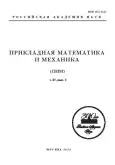Investigation of a Thermal Detonation Wave in a Mixture of Water Drops with Molted Lead
- Авторлар: Melikhov V.I.1, Melikhov O.I.1, Bashar S.1
-
Мекемелер:
- NRU MPEI
- Шығарылым: Том 87, № 3 (2023)
- Беттер: 475-488
- Бөлім: Articles
- URL: https://journals.rcsi.science/0032-8235/article/view/138873
- DOI: https://doi.org/10.31857/S0032823523030098
- EDN: https://elibrary.ru/ZTPPDG
- ID: 138873
Дәйексөз келтіру
Толық мәтін
Аннотация
The patterns of the wave of thermal interaction of water drops in a high-temperature molten lead, are studied. Due to the boiling of water on the surface of molten lead, both liquids (phases) are separated by a vapor film. A one-dimensional model of interacting and interpenetrating continuums is used, which describes the dynamics of each fluid by introducing a special field characterized by its own velocity, temperature, and volume fraction. Wave velocity is determined by the equality of phase velocities and temperatures in the Chapman-Jouguet plane. The parameters at the pressure peak are calculated from the conditions at the discontinuity which are the boundary conditions for integrating the conservation equations in the zone of interaction of water droplets with the melt. The resulting structure of the thermal detonation wave is characterized by the fact that the maximum pressure is at some distance from the shock wave.
Авторлар туралы
V. Melikhov
NRU MPEI
Хат алмасуға жауапты Автор.
Email: MelikhovVI@mpei.ru
Russia, Moscow
O. Melikhov
NRU MPEI
Хат алмасуға жауапты Автор.
Email: MelikhovOI@mpei.ru
Russia, Moscow
Saleh Bashar
NRU MPEI
Хат алмасуға жауапты Автор.
Email: basharsaleh10@gmail.com
Russia, Moscow
Әдебиет тізімі
- Zeldovich Y.B., Kompaneets A.S. Theory of Detonation. Moscow: Gostekhizdat, 1955. 268 p. (in Russian)
- Landau L.D., Lifshits E.M. Theoretical Physics: Textbook. In 10 vols. V. VI. Hydrodynamics. Moscow: Nauka, 1986. 736 p. (in Russian)
- Kraiko A.N. Instability of stationary flows in channels of variable cross-sectional area with a detonation Chempin–Jouguet wave // JAMM, 2019, vol. 83, no. 3, pp. 354–369. (in Russian)
- Vainshtein P.B., Nigmatulin R.I., Popov V.V. Transition of convective combustion of air suspensions of unitary fuel into detonation // Phys. Combust.&Explos., 1980, no. 5, pp. 102–106. (in Russian)
- Nigmatulin R.I., Vainshtein P.B., Akhatov I.Sh. Structure of stationary detonation waves in mixtures of gas with particles of unitary fuel // in: Chem. Phys. Combust.&Explos. Proc. Detonation. Chernogolovka: Inst. Chem. Phys. AS USSR, 1980. pp. 96–99. (in Russian)
- Akhatov I.S., Vainshtein P.B., Nigmatulin R.I. Structure of detonation waves in gas suspensions of fuel containing the oxidant // Fluid Dyn., 1981, vol. 16, pp. 675–681. https://doi.org/10.1007/BF01089577
- Nigmatulin R.I. Dynamics of Multiphase Media. Part I. Moscow: Nauka, 1987. 464 p. (in Russian)
- Board S.J., Hall R.W., Hall R.S. Detonation of a fuel coolant explosion // Nature, 1975, vol. 254, pp. 319–321.
- Melikhov V.I., Melikhov O.I., Yakush S.E. Hydrodynamics and Thermal Physics of Steam Explosions. M.: IPMech RAS, 2020. 276 p. (in Russian)
- Melikhov V.I., Melikhov O.I., Yakush S.E. Thermal interaction of high-temperature melts with liquids // High. Temp., 2022, vol. 60, pp. 252–285. https://doi.org/10.1134/S0018151X22020274
- Sharon A., Bankoff S.G. On the existence of steady supercritical plane thermal detonations // Int. J. Heat Mass Trans., 1981, vol. 24, pp. 1561–1572.
- Frost D.L., Lee J.H.S., Ciccarelli G. The use of Hugoniot analysis for the propagation of vapor explosion waves // Shock Waves, 1991, vol. 1, pp. 99–110.
- Iskhakov A.S., Melikhov V.I., Melikhov O.I., Yakush S.E., Le Tran Chung. Hugoniot analysis of experimental data on steam explosion in stratified melt-coolant configuration // Nucl. Engng.&Design, 2019, vol. 347, pp. 151–157.
- Dinh T.N. Multiphase flow phenomena of steam generator tube rupture in a lead-cooled reactor system: a scoping analysis // Proc. ICAPP 2007, Paper No. 7497. May 13–18, 2007. Nice, France.
- Iskhakov A.S., Melikhov V.I., Melikhov O.I. Hugoniot analysis of energetic molten lead water interaction // Annals of Nucl. Energy, 2019, vol. 129, pp. 437–449.
- Sobolev V. Database of thermophysical properties of liquid metal coolants for GEN-IV. Sodium, lead, lead-bismuth eutectic (and bismuth). Belgian Nuclear Research Centre. Scientific Report SCK CEN-BLG-1069. Boeretang, Belgium. 2010. 175 p.
- IAPWS (The Int. Assoc. for the Properties of Water&Steam). http://www.iapws.org.
- Pilch M., Erdman C.A. Use of breakup time data and velocity history data to predict the maximum size of stable fragments for acceleration-induced breakup of a liquid drop // Int. J. Multiphase Flow, 1987, vol. 13, pp. 741–757.
- Meignen R., Picchi S., Lamome J. et al. The challenge of modeling fuel-coolant interaction: Part I – Premixing // Nucl. Engng.&Design, 2014, vol. 280, pp. 511–527.
- Fletcher D.F., Anderson R.P. A review of pressure-induced propagation models of the vapour explosion process // Prog. Nucl. Energy, 1990, vol. 23, pp. 137–179.
- Fletcher D.F. An improved mathematical model of melt/water detonations – I. Model formulation and example results // Int. J. Heat Mass Trans., 1991, vol. 34, no. 10, pp. 2435–2448.
- Beznosov A.V., Pinaev S.S., Davydov D.V. et. al. Experimental studies of the characteristics of contact heat transfer lead coolant – working body // Atomic Energy, 2005, vol. 98 (3), pp. 182–187. (in Russian)
- Carachalios C., Burger M., Unger H. A transient two-phase model to describe thermal detonations based on hydrodynamic fragmentation // Proc. Int. Meeting on LWR Severe Accident Evaluation, Cambridge, Massachusetts, 28 Aug.–1 Sep. 1983.
- Ishii M., Hibiki T. Thermo-Fluid Dynamics of Two-Phase Flow. N.Y.: Springer, 2011. 518 p.
- Kolev N.I. Multiphase Flow Dynamics. Vol. 1. Fundamentals. N.Y.: Springer, 2015. 840 p.
Қосымша файлдар













